- By Dan Veaner
- News
 Print
Print 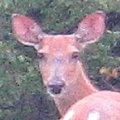 In its second year the Village of Lansing's deer population management program is alive, but limping. The effectiveness of the program is in jeopardy because acreage within the Village that meets the criterion for a hunt is limited. Negotiations with Murray Estates, also known as Sundowns Farm, for a bow hunt there broke down for the second year in a row, leaving very few other eligible properties.
In its second year the Village of Lansing's deer population management program is alive, but limping. The effectiveness of the program is in jeopardy because acreage within the Village that meets the criterion for a hunt is limited. Negotiations with Murray Estates, also known as Sundowns Farm, for a bow hunt there broke down for the second year in a row, leaving very few other eligible properties.With Sundowns out of the picture again this year, the Village obtained only 10 Deer Management Assistance Program (DMAP) tags from the Department of Environmental Conservation (DEC). "I don't think it's going to make any difference in the herd if we take out ten deer," says Village Trustee Lynn Leopold. "I saw 35 on Sundowns. That's probably a sixth of the total herd in the Village. It's not less. Taking out ten right here means that vacuum will be filled very quickly by other animals."
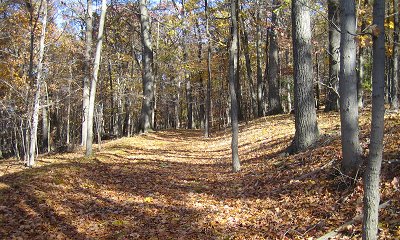
The forest floor is bare, decimated by a deer population too
large to be sustained by local resources.
Village Mayor Donald Hartill says that auto/deer collisions are another result of a deer population that is out of control. "The ten animals represent part of the (population) control," Hartill says. "The other is the highway method. With the highway method we take about 35 animals a year."
Leopold and Hartill live in the west side of the Village, near the old Ithaca/Auburn Short Line railroad bed. While Hartill is plagued by deer, his property isn't big enough to meet DEC conditions for conducting a hunt. "I noticed, coming up on Oakcrest Road, there were probably 20 of them," he says. "They were crossing the road. I've got four or five that just camp in our back yard. They got up on the north deck and ate all of my wife's mums."
With Murray Estates (Sundowns Farm) out of the picture, Leopold's ten acre wooded property is one of the few others in the Village that is large enough to participate. It is the only one so far to participate in the program. Last year she and her husband got two of the 50 DMAP tags the Village had obtained. One hunter used the tags as well as his own and some that had been transferred to him by other hunters. He removed seven deer including the two on the Village tags. The other 48 tags, obtained in anticipation of a hunt on Sundowns Farm, were never used.
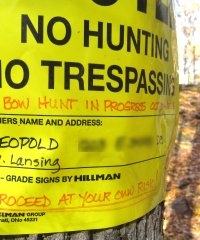 | 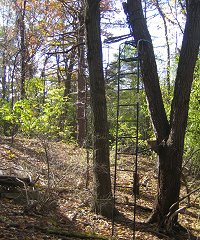 |
| (Left) The boundaries of the population control hunt are posted with warnings so that passers-by, walking in the woods along the old railroad bed will be alerted to stay away. (Right) Deer stands are placed in strategic spots around the Leopold property | |
This year the pickings are slimmer. Since bow season began five weeks ago only two were taken in the first week, and those were very thin. Now that cold weather is settling in another five were taken this week. "They have no fat whatsoever," Leopold says. "Our deer are unbelievably lean. They're overeating the ecosystem. They have nothing to eat. They are starting to browse buckthorn, which is their most dreaded, hated emergency food. Normally they'd be stuffed on acorns."
Leopold's property has been eaten clean by the deer. New growth is instantly eaten, leaving the woods littered with dead sapling stumps, only a few inches high. There are no young trees anywhere to be seen. In desperation she has put up some chicken wire to enclose small areas that are deer-free. The growth within the enclosures is in startling contrast to the bare floor of most of the woods. But it is impractical to fence the entire woods.
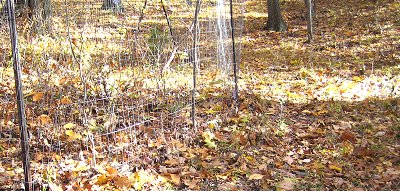 There is a stark contrast between natural growth in small fenced areas protected from the deer (left) and the rest of the understory, which is stripped bare of all new growth |
"It's just heartbreaking for us," Leopold says. "I almost don't want to walk though my own woods because it makes me angry to see how destroyed the understory is. These are huge trees that are probably 150 years old. In another 100 years they'll be gone and there will be no forest to replace it. If we had a healthy forest floor the deer would eat the sedges and other small plants and there still would be enough left over to keep reproducing. But now there's nothing."
DMAP partners the DEC with local municipalities that want to try to control the size of local herds. They provide special deer tags, each one good for a doe. After hunters have used their regular tags, they can continue to hunt until they run out of DMAP tags. In the Village it is against the law to discharge firearms, so DMAP tags are only issued to bow hunters. Bow hunting season began October 18th. Bow hunters may hunt during the shotgun season, which began last Saturday, and beyond until December 16th.
The hunt on the Leopolds' property is private, by invitation only to responsible bow hunters the landowners trust. Last year they invited one accomplished bow hunter to participate, and this year there will be five. Each will get two DMAP tags. Leopold has posted her boundaries with warnings that a private hunt is in progress. She has also alerted neighbors to the hunt and obtained written permission to go onto their property if a wounded deer should wander there.
Between regular deer tags and the ten DMAP tags more than 20 deer could potentially be taken. But that assumes that all five hunters hunt only on the Leopolds' land, and that the deer cooperate by going there. But that is not likely with the food supply extinguished.
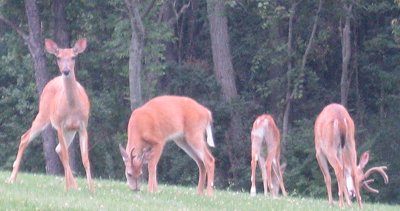
These deer resort to eating lawn and raiding gardens in
Autumn Ridge, not very far north of the Leopold property
Two years ago a large acorn crop attracted huge numbers to the property. But this year deer aren't coming because there is nothing to eat. When the deer herd is too big for the food supply they will eat anything after their preferred species are gone. Preferred species include oaks, maples, other hardwoods, and pine. Deer paths are too numerous, and the only new growth is a weed tree called Buckthorn. Additionally, deer have so compacted the soil that good new growth would have a hard time sprouting if the deer didn't eat it anyway.
Leopold says she has mixed feelings about hosting a hunt. "Hunting is a tough issue," she says. "If you're an animal rights person you wouldn't tolerate it at all, but from an environmental perspective (overpopulation) is not good for the deer and it certainly isn't good for the environment to have too many."
A long-time environmentalist, she notes that a smaller herd means healthier animals and a healthier woodland. She says she has been driven to try the hunt because of the enormous damage her property has suffered. But she is pessimistic that it will be effective.
Leopold remains frustrated because even if the hunt on her property yielded the maximum number of deer, it still wouldn't control the population effectively. She says that a hunt at Murray Estates is what it would take to make a difference in the Village. But with no hunt there, the farm has become a haven for deer. On any given day you can see 20, 30, or more deer on the property.
"It's a sanctuary now because they're not going to be hunted there," Leopold says. "I counted 35 deer there on my way to a Village Board meeting this summer. That's a huge number."
----
v4i45



